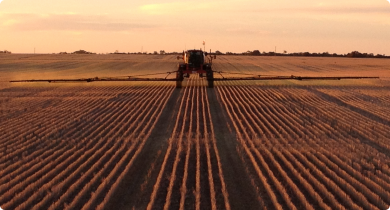Links
Deep ripping shows promise at Mullewa
A compacted and acid hardpan at a subsoil depth of 30-40cm is one of the last big hurdles to increasing crop production on Andrew and Rod Messina’s Mullewa property.
Deep ripping for soil compaction
Deep ripping mechanically breaks up compacted soil layers, however care must be taken to ensure results are effective. Deep ripping uses strong tines working down to 35-50cm depth to loosen hard layers of soil. Tine spacing, working depth, shallow leading tines or discs, soil moisture content, timing and soil type all need to be taken into account. Not all soils and crops respond positively to deep ripping every season. Benefits usually last for about three seasons but can last more than 10 seasons with controlled traffic systems on light sands.
Controlled traffic farming, VNTFA
Controlled Traffic Farming (CTF) is a farming system built on permanent wheel tracks where the crop zone and traffic lanes are permanently separated. By keeping machinery on permanent wheel tracks in every paddock your profitability and sustainability can be improved. The concept of CTF is not new. CTF has been researched and implemented for nearly two decades with Australia’s CTF pioneers coming from both research and farming backgrounds, so the benefits of the system have been measured in all soil conditions and climate zones. Still, the jury remains undecided in a few geographical pockets, making farmers, advisors and agronomists question if the system of conforming to wheel tracks is really worth it.
On the right track - controlled traffic in the low rainfall zone of south-eastern Australia
The aim this book is to provide low rainfall farmers in south-eastern australia with local information on controlled traffic farming and tips for adoption. The book was produced by The Australian Controlled Traffic Farming Assocation's GRDC funded Project ACT00004 "Application of controlled traffic farming in the low rainfall zone".
Soil compaction/constraints
Livestock and light machinery can compact surface soil, and agricultural machinery or natural soil characteristics and conditions can lead to subsurface compaction. Some soils have greater capacity to resist compaction or to self-repair following compaction. Compacted sub-surface soil restricts crop and pasture root growth. The Department of Agriculture and Food, Western Australia can provide technical information to assist landholders to reduce the impacts of soil compaction through improved management practices, such as deep ripping, controlled traffic farming, a change in stock movement and the use of gypsum.
Developing a controlled traffic (tramline) farming system
Controlled traffic farming (CTF) is a farming system built on permanent wheel tracks where the crop zone and traffic lanes are permanently separated. It can improve profitability and sustainability. Implements have a particular span, or multiple of it and all wheel tracks are confined to specific traffic lanes. CTF increases profit by more yield, better grain quality and reduced costs. The environment can improve, with less nutrient leaching, less water erosion, better infiltration and less greenhouse gas emission. Implementation needs a clear, long-term plan and priority of soil health.
Deep ripping and controlled traffic farming a good combination for Eastern Wheatbelt
Controlled traffic farming used in conjunction with deep tillage between the permanent wheel tracks is boosting crop production on WA’s compacted wheatbelt sands.
Researchers and growers are seeing wheat yield responses of up to 1 tonne per hectare where sub-surface compaction is being broken down by deep ripping to a depth of 30-35cm.
Controlled traffic farming
A survey of growers who believed they had implemented controlled traffic farming (CTF) has revealed that many are not gaining the full benefits because they have not implemented some of the essential components of the system.
Controlled Traffic Farming Technical Manual
This manual focuses on developing a CTF system in Western Australia, however it contains information from research and on-farm development of CTF elsewhere in Australia, including the benefits of CTF, compaction identification, machinery options, layout planning and experiences of CTF farmers to help develop a CTF system to suit each farm. There is not one set recipe and the cost of conversion varies greatly depending on the machinery already on-farm. These principles may also be applicable to other farming systems of like scale in other parts of the world.




